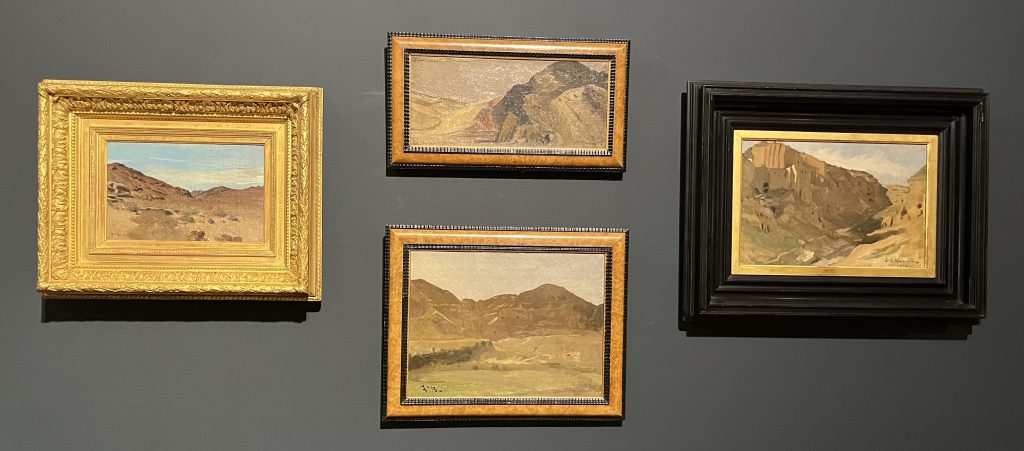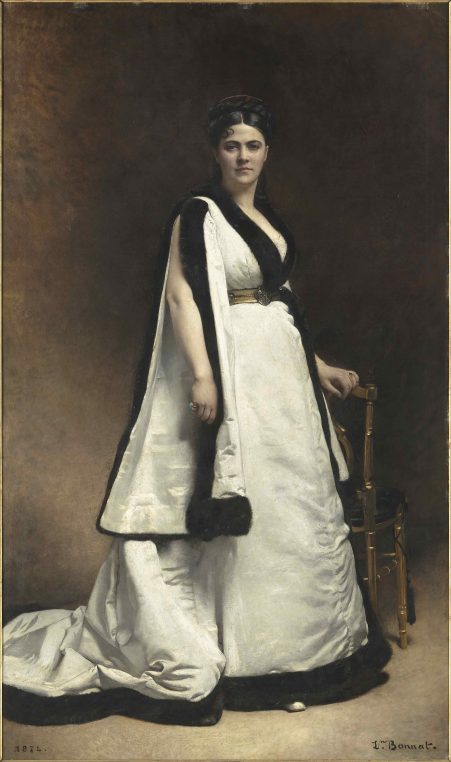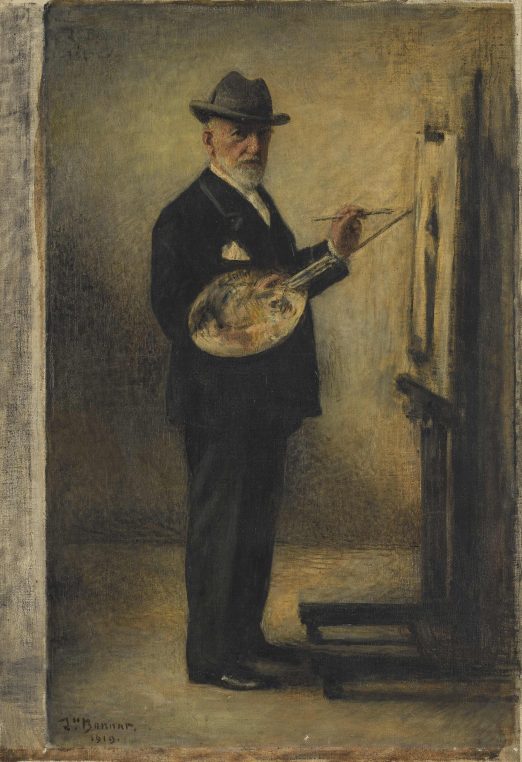Léon Bonnat (1833-1922) is a forgotten painter who was a star in his lifetime, an official portraitist who trained many students when he was director of Ecole des Beaux Arts and helped all Basque artists to come to the capital. He was born in Bayonne, lived for seven years in his teens in Madrid, where he studied with José and Federico de Madrazo, and travelled to Italy at 25. He then settled in Paris and became a praised painter of historical and religious scenes. Many of the portraits exhibited here testify to his aristocratic and rich Jewish models, a clientele he largely developed in the late 1870’s and 1880’s. The show, curated by Sabine Cazenave and Benjamin Couilleaux, is the first since he died in 1922. It is definitely the event of the Côte Basque this summer.

“View of the Sinaï”, 1868, Gift of the Friends of Musée Bonnat, “The Sinaï”, 1868, Dijon, Musée des Beaux Arts, “Landscape in Jericho”, 1868, Dijon Musée des Beaux Arts, “Mar Saba”, monastery near Jerusalem, 1868, Bayonne Musée Bonnat Helleu
This exhibition at Musée Basque is particularly important since Musée Bonnat-Helleu has been closed for many years and will probably not reopen until 2025. It is undergoing important restorations and was at the center of multiple feuds within the town of Bayonne. But the determination of Sabine Cazenave, director of Musée Basque, is intact and even though her name did not appear on the invitation to the opening (only the prefect and the mayor and multiple municipal deputies did), she runs the place with an iron hand. The design of the show and the involvement of the great designer Philippe Apeloig in the graphism, is proof of it. Previously in charge of the Art museum in Amiens and curator at Musée d’Orsay, Cazenave managed to get fabulous loans from the Louvre, Musée d’Orsay, Versailles, Petit Palais, etc…
One person is missing though in the catalog as well as in the scientific direction of the retrospective: Guy Saigne, who was awarded a prize by the French Academy for his large study of Bonnat’s portraits and will publish the second tome of the catalog raisonné with an introduction by Pierre Rosenberg at the end of the year. He is a collector and a financier turned academic twenty years ago who presented his doctorate thesis in 2015. He concentrates on the painters’s relations with the III rd Republic and his portrays of everyone who counted from duc d’Aumale to the Vanderbilts and the Astors. Léon Bonnat willed all his collections of paintings to then city of Bayonne.

Marguerite Franchetti, 1875, Musée Bonnat-Helleu, Evelyne Frances Bodley, born Evelyn Frances Bell, 1895, Comtesse Louise Cahen d’Anvers, ca 1875, Musée Bonnat-Helleu, Ignacy Paderewski, ca 1905-1907, Musée Bonnat-Helleu
The rooms are not always high enough to show Bonnat’s masterpieces but the hanging of small paintings together on one wall facing the huge portraits is efficient. And there are many studies which Sabine Cazenave considers as especially good. One intriguing painting inside the Sixtine Chapel with a large red carpet is very modern and one wonders who the lady dressed in black is on the left? If I had to steal one painting from the show, it would be the “Lake of Gerardmer” which Bonnat painted while visiting the Cahen d’Anvers. It is one of his rare French landscapes and it is painted at night.

Portrait presumed to be of Henriette Halphen, born Henriette Stern, 1879, Bayonne Musée Bonnat-Helleu
In 1868, Bonnat travelled with Jean-Léon Gérôme to the Middle East from Egypt to Beyrouth via Jerusalem, and painted a series of oils on canvas which are charming. His most famous works are the portrait of Alexandre Dumas fils, Ernest Renan, Armand Fallières, the President of France in 1907 and Victor Hugo (both lent by Musée d’Orsay), Léon Gambetta in 1888, and also the one of Pasteur which is presently shown at Petit Palais. Towards the end of the show, a Christ on the Cross and two large paintings of Justice and Strength are very striking. One large portrait of Cardinal Lavigerie was painted with Daniel Saubès. A very dark work of Adolphe Thiers, entirely black, except for his left hand closes the show with great style.
The Musée Basque et de l’Histoire de Bayonne is well worth a visit for it has important collections of local painters and the history of the city which was a very busy harbor in the 17 th and 18 th century when the Gramont were governors. It was also a center for manufacturing chocolate and on the main street there are numerous chocolate shops including my favorite, Pariès which makes the best canougat (caramels) in the world. They also have a shop in Saint Jean de Luz and in Biarritz.
The show is on until December 31. Do not miss it.
You can read Guy Saigne’s book “Léon Bonnat, portraitist of the III rd Republic” published by Editions Mare &Martin.
Share this Post




One Comment on “A Léon Bonnat retrospective… at last!”
Chère Laure, je souhaite m’inscrire et suivre votre blog ! Très belle fin d’été et à très bientôt